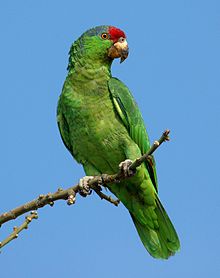Green-cheeked Amazon
| Green-cheeked Amazon | ||||||||||||
|---|---|---|---|---|---|---|---|---|---|---|---|---|

Head coloration in a female |
||||||||||||
| Systematics | ||||||||||||
|
||||||||||||
| Scientific name | ||||||||||||
| Amazona viridigenalis | ||||||||||||
| ( Cassin , 1853) |
The Red-Crowned Amazon ( Amazona viridigenalis ) is a parrots art from the genus of the Amazon parrot ( Amazona ).
Appearance
The green-cheeked amazon belongs to the medium-sized amazon species. Their body length is 31–35 cm. It has dark green plumage; The forehead and top of the head are bright red, the area behind the eyes is blue-violet, the beak is horn-colored and yellow. There are no clear differences between the sexes, the extension of the red feathers on the vertex is less in the female.
distribution
The green-cheeked amazon lives in northeast Mexico preferentially in forest areas and open landscapes with trees.
attitude
Green-cheeked amazons, like all parrots, should never be kept alone, with the exception of intolerant birds, which have reacted with aggressive behavior towards or fear of the conspecifics after repeated attempts at reasonable intervals to socialize it with other parrots. Keeping in pairs or groups is considered species-appropriate. Individual animals that are very human-related require a lot of attention and often play a dominant role within families. Green-cheeked amazons need a varied diet consisting of seeds, green fodder, buds, berries, fruit and, especially when rearing young, also germ feed and animal protein. It is also a good idea to take up minerals from the earth.
literature
- Dieter Hoppe : Amazons. Ulmer, Stuttgart 1983, ISBN 3-8001-7087-6 , p. 78.
- Rosemary Low: The Parrot Book. Ulmer, Stuttgart 1983, ISBN 3-8001-7090-6 , p. 271.
swell
- ↑ In Austria it is even required by law: Appendix 2: Minimum requirements for keeping birds of the 2nd Animal Husbandry Ordinance, homepage of the Austrian Federal Chancellery
Web links
- Amazona viridigenalis in the endangered Red List species the IUCN 2008. Posted by: BirdLife International, 2004. Retrieved on January 3 of 2009.
